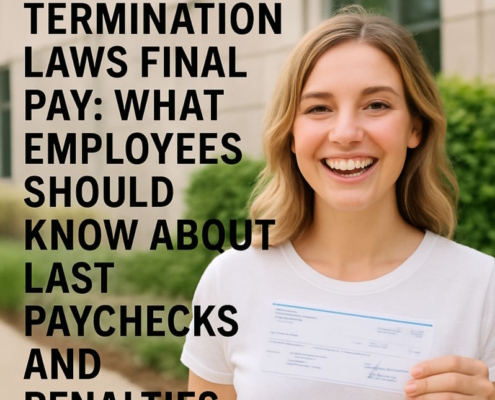Breach of Employment Contract by Employer
An employment contract breach can occur because the employer or employee breached a written contract, implied contract, or verbal contract. The employment contract sets out legally enforceable terms and conditions that govern the working relationship between the employer and employee.
Author: Douglas Wade, Attorney
Email | Call (800) 484-4610
An employment contract is “breached” when one party doesn’t live up to its end of the bargain. An employer may breach an employment contract by violating the terms of an employment contract with an employee.
In this article, our California employment lawyer for employers will discuss breach of employment contract as follows:
Definition
An employer breaches an employment contract having a specified term if the employer terminates the contract prior to the expiration of the term without “good cause.” In this context, “good cause” means the employee’s willful breach of, habitual neglect of, or continued incapacity to perform his or her duties. (Cal. Lab. Code, §2924; see also BAJI 10.04, 10.31, 10.32.)
There is presumption of at-will employment if parties have made no express oral or written agreement specifying length of employment or grounds for termination; however, such presumption may be overcome by evidence that despite absence of specified term, parties agreed that employer’s power to terminate would be limited in some way, e.g., by requirement that termination be based only on “good cause.” (Cal. Lab. Code, §2922.)
“[L]abor Code section 2924 has traditionally been interpreted to ‘inhibit[] the termination of employment for a specified term except in case of a wilful breach of duty, of habitual neglect of, or continued incapacity to perform, a duty.’ ” (Khajavi v. Feather River Anesthesia Med. Grp. (2000) 84 Cal.App.4th 32, 57.)
Note: For a breach of employment contract, a termination may be either actual or constructive. A termination is actual when the employer tells the employee, orally or in writing, that the employment is terminated. (Turner v. Anheuser-Busch, Inc. (1994) 7 Cal. 4th 1238, 1244-45) In employment contract breach, a termination is constructive when the employee is effectively forced to resign due to intolerable working conditions that the employer either created or knowingly permitted. (Id. at p. 1246 [“a constructive discharge is legally regarded as a firing rather than a resignation.”]; see also BAJI 10.02.)
Elements of Breach of Employment Contract for a Specified Term
CACI No. 2420
For a breach of employment contract, the elements are:
[Name of plaintiff] claims that [name of defendant] breached an employment contract for a specified term. To establish this claim, [name of plaintiff] must prove all of the following:
- That [name of plaintiff] and [name of defendant] entered into an employment contract that specified a length of time that [name of plaintiff] would remain employed;
- That [name of plaintiff] substantially performed [his/her/nonbinary pronoun] job duties [unless [name of plaintiff]’s performance was excused [or prevented]];
- That [name of defendant] breached the employment contract by [discharging/demoting] [name of plaintiff] before the end of the term of the contract; and
- That [name of plaintiff] was harmed by the [discharge/demotion]
Element 1: Valid Employment Contract With Specified Term
A contract of employment is a contract by which one, the employer, engages another, the employee, to do something for the benefit of the employer or a third person. (See Cal. Lab. Code §2750; Cal. Civ. Code §1549.) A contract has a specified term of employment if it specifies a term that is greater than one month. (See Cal. Lab. Code §2922.)
In a breach of contract by employer, the plaintiff must prove the existence of a valid employment contract to prevail on a breach of employment contract claim. (Wise v. Southern Pacific Co. (1963) 223 Cal. App. 2d 50, 59.)
Employment contracts are governed by general contract law. (Reynolds v. Electric & Engineering Co. v. W.C.A.B. (1966) 55 Cal. 2d 429, 433 [“[a] contract of employment is governed by the same rules applicable to other types of contracts.”].)
The only proper defendant in a breach of employment contract action is the employer (a party to the employment relationship), not other employees. (See, e.g., Cleary v. American Airlines, Inc. (1980)111 Cal. App. 3d 433, 456 [co-workers were not liable for breach of implied covenant of good faith and fair dealing]; Shoemaker v. Myers (1990) 52 Cal. 3d 1, 25 [it is “well-established that corporate agents and employees acting for and on behalf of a corporation cannot be liable for inducing a breach of the corporation’s contract”].)
Generally, public employees may not assert breach of contract claims. (Miller v. State (1977) 18 Cal. 3d 808, 813.)
Element 2: Employee Substantially Performed Job Duties
Unless excused, the employee must demonstrate that he or she was performing his or her duties adequately. (Wise v. Southern Pacific Co. (1963) 223 Cal. App. 2d 50, 59; see also Cal. Civ. Code, §§1439-1440; Cal. Lab. Code, §§2854, 2856-2859.)
The plaintiffs bear the burden of proving that they stood ready to or actually did perform their duties adequately. (Wise v. Southern Pacific Co. (1963) 223 Cal. App. 2d 50, 59.)
The employees must not only use ordinary care and diligence in the performance of their duties, but also must substantially comply with all directions of their employers unless the directions are impossible, unlawful or would impose new and unreasonable burdens on the employees. (Cal. Lab. Code, §§2854, 2856.)
Moreover, to prove a breach of employment contract, the element of substantial performance should not be confused with the “good cause” defense: “The action is primarily for breach of employment contract. It was therefore incumbent upon plaintiff to prove that he was able and offered to fulfill all obligations imposed upon him by the contract. Plaintiff failed to meet this requirement; by voluntarily withdrawing from the contract he excused further performance by defendant.” (Kane v. Sklar (1954) 122 Cal.App.2d 480, 482; see also CACI No. 2420.)
Element 3: Discharge Before Term Expired
The employer must have discharged the employee before expiration of the term without good cause. (See Cal. Lab. Code, §2924; BAJI 10.04.)
The plaintiff must prove that the employer terminated his or her employment prior to the expiration of the contract term. (Wise v. Southern Pacific Co. (1963) 223 Cal. App. 2d 50, 59.)
The termination may be actual or constructive. (Turner v. Anheuser-Busch, Inc. (1994) 7 Cal. 4th 1238, 1244-45.)
To constitute a constructive discharge, the employee must prove that the employer either intentionally created or knowingly permitted working conditions that were so intolerable or aggravated at the time of the resignation that a reasonable employer would realize that a reasonable person in the employee’s position would be compelled to resign. (Turner v. Anheuser-Busch, Inc. (1994) 7 Cal. 4th 1238, 1251 [no constructive discharge in case alleging retaliatory wrongful termination and termination in violation of public policy].)
Element 4: Discharge Without “Good Cause”
Good cause exists if the employee’s willful breach, habitual neglect, or continued incapacity means that the employee does not perform the duties of employment. (Cal. Lab. Code, §2924; BAJI 10.32.)
In proving wrongful termination of a breach of employment contract with a specified term, the “good cause” needed is quite different from that necessary to prove wrongful termination of an implied contract not to discharge without good cause. (Pugh v. See’s Candies, Inc. (1981) 116 Cal. App. 3d 311, 330.)
An employment contract may set forth a different standard for termination than that provided for in Labor Code §2924. (See, e.g., R.J. Cardinal Co. v. Ritchie (1963) 218 Cal. App. 2d 124, 143 [“A contract may contain a valid provision giving one or either of the parties thereto an option to terminate it within a certain time or on specified conditions.”].)
Element 5: Causation and Damages
In a breach of contract by employer, the termination must cause the employee damage. (Wise v. Southern Pacific Co. (1963) 223 Cal. App. 2d 50, 59; Cal. Civ. Code, §3300; see also BAJI 10.04.)
“The plaintiff has the burden of proving his damage. The law is settled that he has the duty of minimizing that damage. While the contract wages are prima facie [evidence of] his damage, his actual damage is the amount of money he was out of pocket by reason of the wrongful discharge.” (Erler v. Five Points Motors, Inc. (1967) 249 Cal.App.2d at pp. 567-568.)
Remedies
Contract Damages
Contract damages are of two types – general damages (sometimes called direct damages) and special damages (sometimes called consequential damages). (Lewis Jorge Construction Management, Inc. v. Pomona Unified School Dist. (2004) 34 Cal.4th 960, 968.)
“Contract damages are generally limited to those within the contemplation of the parties when the contract was entered into or at least reasonably foreseeable by them at that time; consequential damages beyond the expectation of the parties are not recoverable. This limitation on available damages serves to encourage contractual relations and commercial activity by enabling parties to estimate in advance the financial risks of their enterprise.’ ‘In contrast, tort damages are awarded to [fully] compensate the victim for [all] injury suffered.” (Erlich v. Menezes (1999) 21 Cal.4th 543, 550.)
Equitable Remedies Not Available
The obligation to employ another in personal service cannot be specifically enforced. (Cal. Civ. Code, §3390.)
Punitive Damages Not Available
California courts do not recognize a right to punitive or exemplary damages for breach of employment contract, unless the breach occurs in connection with an intentional tort. (Foley v. Interactive Data Corp. (1988) 47 Cal. 3d 654, 700.)
Emotional Distress Damages Typically Not Available
Cases permitting recovery for emotional distress typically involve mental anguish stemming from more personal undertakings the traumatic results of which were unavoidable. Thus, when the express object of the contract is the mental and emotional well-being of one of the contracting parties, the breach of the contract may give rise to damages for mental suffering or emotional distress. (Erlich v. Menezes (1999) 21 Cal.4th 543, 559.)
Attorney’s Fees if Provided For in Employment Contract
“In the absence of a statute authorizing attorneys’ fees as an element of damages, or of a contract to pay such fees in event of the party’s recovery, attorneys’ fees paid by a successful party in an action are never recoverable against the unsuccessful party.” (Jen–Mar Constr. Co. v. Brown (1967) 247 Cal.App.2d 564, 573; Cal. Code Civ. Proc., § 1021.)
Statute of Limitations
The statute of limitations for breach of a written employment contract is four years. (Cal. Civ. Proc. Code, §337(1).) The limitations period for breach of an oral contract is two years. (Cal. Civ. Proc. Code, §339(1).) If you are alleging tortious breach of contract causing personal injury, then the statute of limitations is two years. Note: Prior to 2003, the statute of limitations for personal injury actions was one year from the date of injury. (Cal. Civ. Proc. Code, §340.) Effective January 1, 2003, the new Code of Civil Procedure §335.1 extends the statute of limitations to two years.
Affirmative Defenses
Good Cause Defense
Plaintiff claims a breach of employment contract. An employer is justified in discharging his employee, when the latter fails to perform his duty, even though injury does not result to the employer as a result of the employee’s failure to do his duty. (Bank of America National Trust & Savings Ass’n v. Republic Productions, Inc. (1941) 44 Cal.App.2d 651, 654.)
“To terminate an employment without the expiration of its contractual term ‘there must be good cause.’ The grounds for terminating such an employment are stated in Labor Code section 2924…. It is therefore not every deviation of the employee from the standard of performance sought by his employer that will justify a discharge. There must be some ‘wilful act or wilful misconduct…’ when the employee uses his best efforts to serve the interests of his employer.” (Holtzendorff v. Housing Authority of the City of Los Angeles (1967) 250 Cal.App.2d 596, 610.)
“An employment agreement that specifies the length of employment (e.g., two years) limits the employer’s right to discharge the employee within that period. Unless the agreement provides otherwise (e.g., by reserving the right to discharge for cause), the employer may terminate employment for a specified term only for [the grounds specified in Labor Code section 2924].” (See CACI No. 2421.)
Elements of the Good Cause Defense for Breach of Employment Contract for a Specified Term; CACI No. 2421
Daniel claims that he did not breach the employment contract because he fired Paula for good cause. To establish good cause, Daniel must prove: (1) that Paula willfully breached a job duty; or (2) that Paula continually neglected her job duties; or (3) that a continued incapacity prevented Paula from performing her job duties.
Employee’s Duty to Mitigate Damages
Employee claims that the employer breach of contract. “[T]he contract compensation for the unexpired period of the contract affords a prima facie measure of damages; the actual measured damage, however, is the contract amount reduced by compensation received during the unexpired term; if, however, such other compensation has not been received, the contract amount may still be reduced or eliminated by a showing that the employee, by the exercise of reasonable diligence and effort, could have procured comparable employment and thus mitigated the damages.” (Erler v. Five Points Motors, Inc. (1967) 249 Cal.App.2d 560, 562.)
Plaintiff claims a employment contract breach. “The burden of proof is on the party whose breach caused damage, to establish matters relied on to mitigate damage.” (Steelduct Co. v. Henger-Seltzer Co. (1945) 26 Cal.2d 634, 654.)
Have a quick question? We answered nearly 2000 FAQs.
See all blogs: Business | Corporate | Employment
Most recent blogs:
































